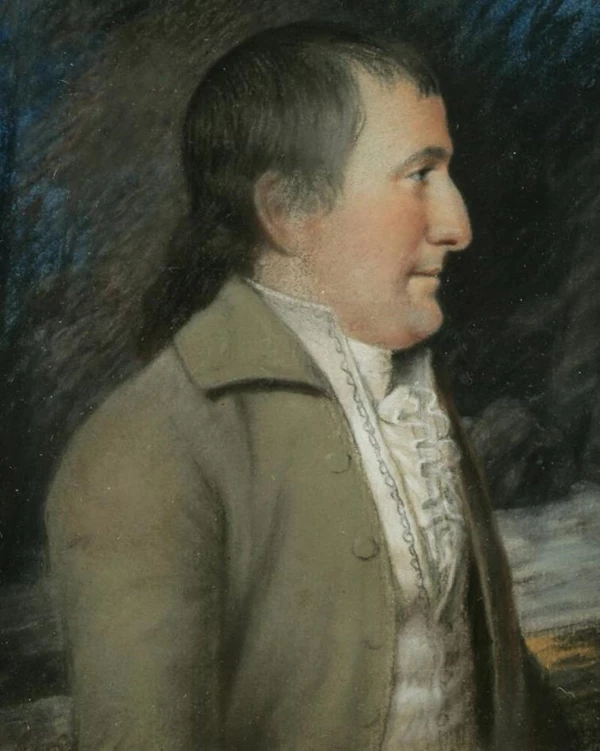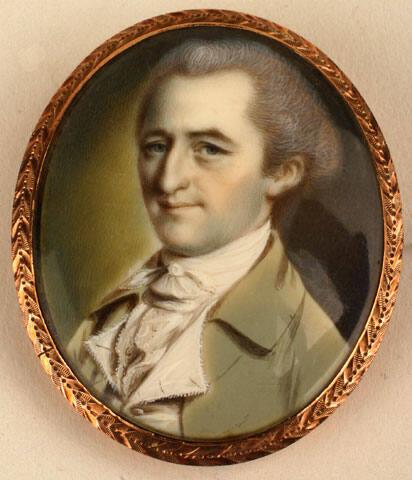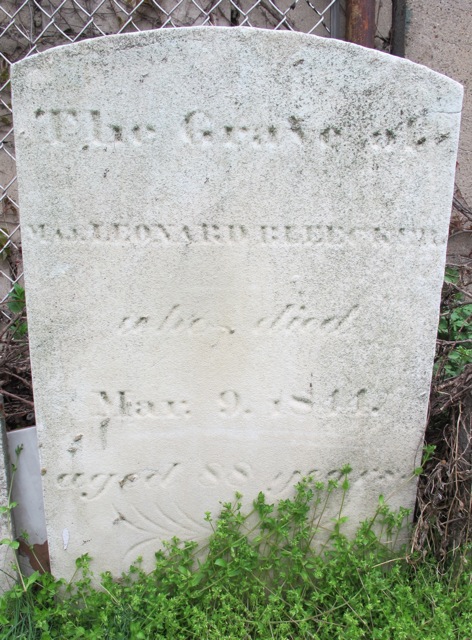Last updated: January 29, 2025
Person
Leonard Bleeker

James Sharples. Bequest of Mrs. Elizabeth B. Knight, great-granddaughter of the sitter.
Leonard Bleeker was born to Jacobus Rutger Bleecker and Abeltje Lispenard on December 21, 1755 in New Rochelle, Westchester in the British Colony of New York. He was baptized on May 4, 1756 with his uncle Leonard Bleeker and aunt Mabelle Stoupe as his godparents. He was one of approximately 10 children.
On June 28, 1775, he became a 2nd lieutenant in the 1st NY Regiment of the Continental Line, serving under General Richard Montgomery. He participated in Montgomery’s campaign against Canada and was present for the attacks and surrenders of St. John’s and Montreal. On December 25th of that year, he participated in the assult on Quebec that led to the death of Montgomery. In the aftermath, most of the regiment spent a cold winter living on the outskirts of the city on what provisions they could gather from the locals, before returning to New York as the snow thawed in spring of 1776.
On November 20, 1776, he was promoted to the rank of captain in Colonel Peter Gansevoort’s 3rd NY Regiment. In spring of 1777, the regiment was sent to garrison Fort Schuyler (formerly Stanwix) on the border of the new United States of America. Over the course of the summer, the fort became the focus of tensions between the US and Britain. Beginning in June, multiple soldiers and three young women were attacked, kidnapped, mutilated, and/or murdered by loyalist and Native forces allied with the British.
In preparation for a larger assault, Bleeker led the efforts of the Continentals and local militia in downing trees to obstruct Wood Creek, the westernmost water way on the Oneida Carry, and slow down any large armies that might approach from that direction. His company was assigned to protect the northeast bastion/corner of the fort. On August 2, 1777, the fort came under attack by the forces under command of Brevet General Barry St. Leger. An unconditional surrender on the part of the Americans was requested a rejected “with disdain.” A siege of 21 days ensued, with the Americans holding the fort. Throughout the siege, several of Bleeker’s men were wounded and one of his men’s wives was wounded and gave birth. Despite their victory and a commendation that followed (from the Continental Congress), the regiment remained stationed at the lonely outpost for another year.
After leaving Fort Schuyler, Bleeker was given a commission as brigade major for the forces of General John Sullivan. During the campaign against the Haudenosaunee peoples that followed in spring and summer of that year, Bleeker was responsible for facilitating communications between the various regiments and companies involved and assigning various jobs. In 1780, served shortly again as a captain of light infantry in the reorganized 1st NY Regiment under Colonel Goose Van Schaick before becoming brigade major for the Marquis de Lafayette from May to October of 1781. It is under Lafayette’s command is where Bleeker witnessed the surrender of British General Cornwallis at the Siege of Yorktown. Bleeker remained a captain in the 1st NY until the signing of the Treaty of Paris in 1783. In 1783, he also became a founding member of the Society of Cincinnati, a Continental Officer veterans’ organization.
Bleeker was known as a fiery personality with a penchant for business. On one occasion. during his tenure at Fort Schuyler, he was personally called out in regimental orders in December 1777, by Colonel Gansevoort for his disregard for timeliness. There was an incident in May 1778, in which another officer made a charge of abuse against him. After an investigation, the accusations were dismissed. But in May 1782, he was convicted at a court martial of “ungentleman-like behavior, in striking and abusing” an ensign and was sentenced to be reprimanded in brigade orders. However, still he remained well known enough (if not well regarded) in 1789 to personally appeal to George Washington for an office in the new government under the Constitution.
Below: An image of Bleeker circa 1790 by artist John Ramage. Gifted to the The New York Historical Society Museum & Library by his great-granddaughter. 
His business acumen served him well later in life when he, his older brother Anthony Lispenard Bleeker (the famed financier of “Bleeker Street” in New York City), and 22 other men signed the Buttonwood Agreement on May 17, 1792. This agreement became the founding document of the New York Stock Exchange. He became a well-regarded stockbroker on Wall Street.
Bleeker was married twice in his lifetime. The first time was to Johanna Abeel in 1783. They had six children: Elizabeth, Leonard, Edward, Gertrude, George Washington, and Jacob. In 1818, presumably after Johanna’s passing, Bleeker married Grace Berrian Moore. Together they had Maria.Around the time of the War of 1812, Bleeker’s monetary luck had run out and he became indebted to multiple people to keep his family afloat. Several of his adult and teenage children took odd jobs at this point as well. March of 1818, the U.S. Congress passed “An act to provide for certain persons engaged in the land and Naval Service of the United States during the Revolutionary War,” which allowed for pensions to be given to veterans of the American Revolution. While assisting several of his former soldiers in applying, Bleeker too applied for a veteran’s pension to aid him.
According to his official deposition the entire sum of his belongings totaled barely $200. This included his clothing, religious books, three beds and the bedding needed for them, and the furniture to make one room comfortable for his wife. He also owned a pew in the New Dutch Church at a value of $300, however that was now owed to two friends in payment for a $550 loan they had given him. He also owed rent to his landlord and was forced to sell the rest of his furniture and belongings to try and make up the difference. His pension was granted at the rate of $240 per year. A rate that was raised to $480 and then $524 because of his ranking in the military.
Bleeker died on March 9, 1844 at the age of 88 years old in New Rochelle, NY. He was survived by five of his older children. He was buried at the Reformed Church of Newtown Cemetery in Elmhurst, NY.
Below: An image of Leonard Bleeker's tombstone. 
Sources
-
Leonard Bleeker (1755 – 1855). WikiTree.com. Accessed November 30, 2022.
-
The New York Historical Society Museum & Library. Accessed November 30, 2022.
-
The US National Archives, Founders Online. Accessed November 30, 2022.
-
The Buttonwood Agreement Wiki. Accessed November 30, 2022.
-
The Pension Application for Leonard Bleeker. Accessed November 23, 2022.
